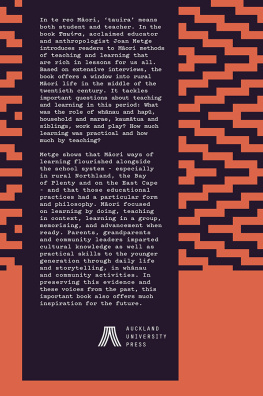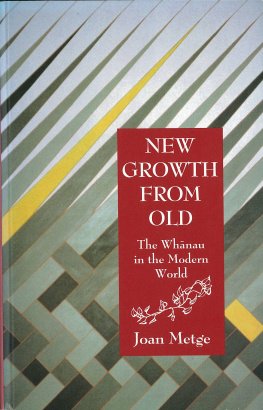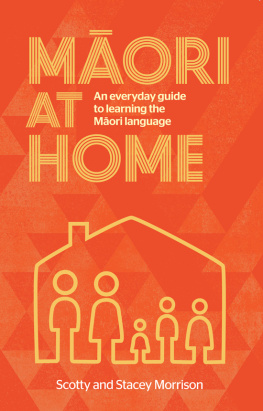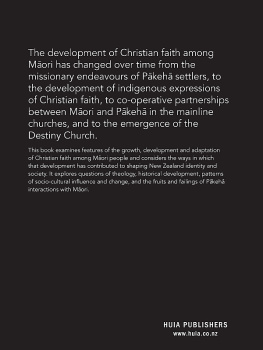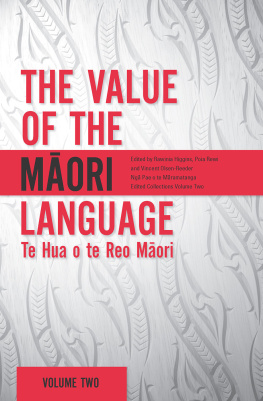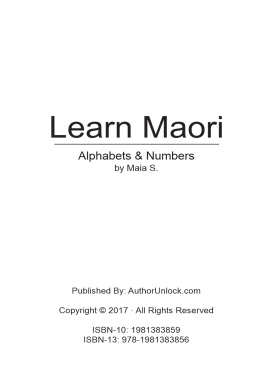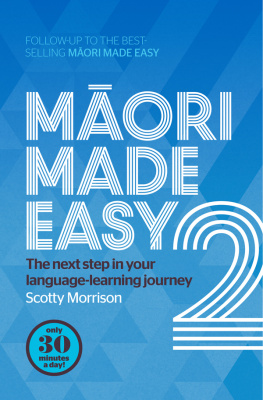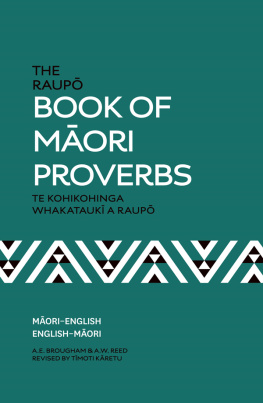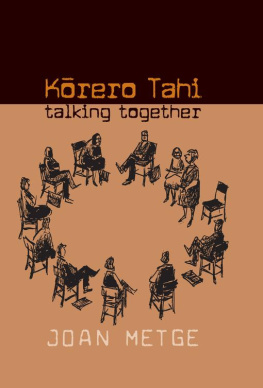Joan Metge was born in Auckland, New Zealand, in 1930. An anthropologist by training and a teacher for many years at Victoria University of Wellington, she is particularly well-known as a researcher in Mori communities. She is a leading scholar on Mori topics, noted for her outstanding promotion of cross-cultural awareness, and has published a number of important books on Mori society and cross-cultural communication. They include The Maoris of New Zealand (1967; revised 1976; and later republished by Routledge as Rautahi: The Mori of New Zealand), Talking Past Each Other (1978/1984), In and Out of Touch (1986), New Growth From Old (1995), Krero Tahi: Talking Together (2001) and Tuamaka: The Challenge of Difference in Aotearoa New Zealand (2010). She was created DBE in 1987. Dame Joan was awarded the Royal Society of New Zealands inaugural Te Rangi Hiroa Medal in 1997 for her outstanding scientific research in the social sciences and in 2006 she received the Asia-Pacific Mediation Forum Peace Prize.
TAUIRA
Mori Methods of Learning and Teaching
Joan Metge

Contents
He Mihi
He mihi aroha tnei ki ng Maunga Krero katoa o te Motu. Mharo ana te ngkau ki ng Mngai Krero o ng iwi whnui i homai nei i rtau whakaaro taahua hei kkahu hei tautoko hoki i ng kupu krero o Tauira. Kei te tangi atu hoki te ngkau m Sonny Wilson m, m Hapi Potae rua ko Akuhata Tangaere, m Priscilla Manukau m, kua wehe atu ki te P. E koutou m, moe mai i roto i te Ariki. Moe mai hoki r i Paerau. Tai p ki te hunga kua hinga ki tua, tai awatea ki te hunga e takat ana i runga i te mata o te whenua. N reira, tn koutou, tn koutou, tn koutou katoa.
Wiremu Kaa, Rangitukia, 2015
He Mihi
From conception to publication, this research has been a collaborative enterprise, Mori and Pkeh working together to record aspects of the past for the generations to come. Now that this waka is launched, I pay tribute to the kai-whakauru who helped build it. Returning aroha for aroha, I thank them for their friendship and support over many years and for their generosity in sharing their names and memories with the readers of this book. I mourn the loss of those who have died, and thank their whnau for supplying details for the biographies.
I am grateful to the readers who made helpful comments on the draft text: Wiremu and Jossie Kaa, George Parekowhai and Haare Williams representing the kai-whakauru, and Alison Jones, Jane McRae, Wally Penetito, Charles Royal and Lynne Tito as educators. I acknowledge my debt to the Royal Society of New Zealand for the award of the Cook Fellowship (198183) which made the original research possible. For their patience and understanding in realising our vision, the kai-whakauru and I give grateful thanks to Sam Elworthy, Anna Hodge, Katrina Duncan and the workers behind the scenes at Auckland University Press, and also to copyeditor Ginny Sullivan and cover designer Johnson Witehira. Kia ora koutou katoa.
Joan Metge, Auckland, 2015
All my relatives lived just over the fence. That was the p. We played in each others backyards or wed go to the river to swim. We all had jobs to do Up at 5 a.m., light the fire, feed the chickens, milk the cow After school, we came back, we were going to look for kai, picking ph, peeling potatoes Especially on Sundays, everyone would take food and go to the gardens. There were acres and acres of it. We werent taught what to do, we learnt by watching them do it. When you are four or five, you water the plants. HONE PIRIHI
Finding kaimoana was our fun. We knew when we got home wed get a hiding for not saying where we were going. So the thing was to bring home a kit of crayfish or kinas If they had a big hui coming up they wouldnt go to a section of the beach till the hui was near and everyone, fifty to a hundred people, would go down and get it all in one day. TE AOMARAMA MATETE
We didnt have a lot but what we had we shared and we never went without. Money just wasnt around, but we were never hungry. Because if they knew our rua was empty, well, Haere mai, come and get something to eat. MATEOHORERE KAA
I remember starting out at school, my koroua taking me to the side of the puna, doing a karakia there; and the iriiri or sprinkling of water on my head, and sending this child to school, a sort of dedication for the purposes that he wanted me to have in life. And one of those was this idea of being a repository of information for the people. HAARE WILLIAMS
When they would plant, they would say, Aa, this is for us, this is for the marae. My mothers uncle would say, Aa, m ng mea pani, for the orphans. So there would be main crops for the family, some for the marae and some for the orphans. WIREMU KAA
The old people live on the marae. Theres about three kaumtuas real kaumtuas with tokotokos and old kuias, sitting around with us, and theres oodles of kids, and theyre telling us stories. How people got to Pawarenga, how the local mountains were named. And we are sitting on the marae and we are looking out at these mountains. NIKORA ATAMA
In my childhood it was the accepted thing, when we went to Karepnia church [on the hill], afterwards we came down to Karepnia marae. On their way to church everybody dropped in a plate of meat or whatever as their contribution to the communal lunch. When we came down to the marae there would be the usual whaikrero as lunch was prepared by the women. Wed all sit down to a meal. If there was any take [issue] that concerned the tribe, after lunch it was discussed and resolved. About milking time, people began to disperse. MAORI MARSDEN
CHAPTER ONE
Voices from the Past
The voices from the past that light up the pages of this book are the voices of Mori adults recalling what it was like growing up in Mori rural communities over fifty years ago. I recorded them on tape in the early 1980s in the course of collaborative research on the whnau in the modern world. Aspects of that research were published in In and Out of Touch (1986) and New Growth From Old (1995). Completing the series on that research, this book focuses on Mori methods of learning and teaching in whnau and community.
Background: The Research in Context
As a Pkeh child living in small rural towns with teacher parents, I was exposed to constant discussion of teaching methods, caught tantalising glimpses into the Mori world through Mori friends, and developed an enduring interest in the problems and rewards of cross-cultural communication. In the 1950s, as a newly qualified social anthropologist and with the support of Mori mentors, I spent two and a half years carrying out research into Mori urban migration by talking face to face with Mori living in Auckland city and a rural community in Northland, and another two years writing up my findings as a PhD thesis at the London School of Economics. Those years established a pattern of collaboration that endures to this day (Metge, 2010, pp.10722).
Returning to New Zealand in 1958, I renewed friendships with colleagues working in Mori education and read a succession of educational reviews, conference reports and media articles as they were published during the following years. I was shocked to find that the phrase Mori education was invariably used in these publications to refer to the education of Mori children in the formal school system, a usage that implicitly denied the very existence, let alone the value, of the learning and teaching taking place in Mori homes and communities. Moreover, the reported underachievement of Mori children in state schools was commonly attributed to deficiencies in the childrens home environment, a conclusion based on non-Mori assumptions about Mori communities and reinforced by the deficit theories then in vogue overseas.
Next page
